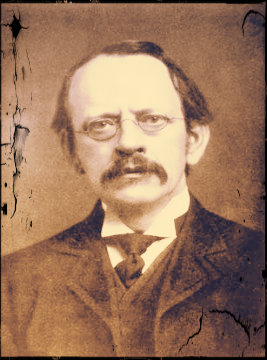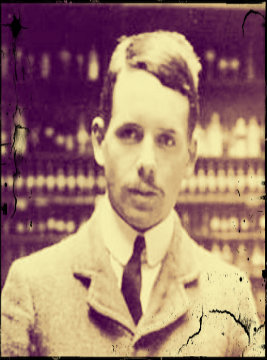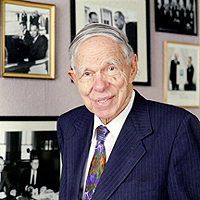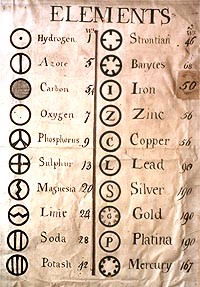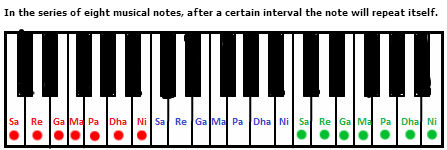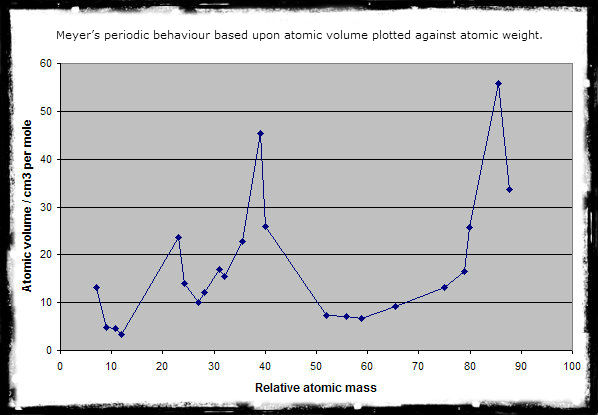February 7, 2026, Periodic Table Day will be celebrating 155 years of Periodic Law and the Periodic Table. Mendeleev is the father of the periodic table because his 1871 table was the first to show periodicity.
It may seem confusing that the periodic table is 155 years old, since Mendeleev's 1869 table didn't display periodicity. John Newlands had the correct idea concerning the octave pattern associated with the elements, however he did not show or place his elements correctly on his 1863 table. Why celebrate Periodic Table Day on February 7? Newlands was the first to propose an octave pattern with the elements. The octave pattern produces periodic law. Even though the law of the Octaves was proven incorrect concerning ordering the elements by mass, the octet rule is still based on eight groups. Having the correct idea does not mean it will be used correctly, Newlands failed to order families of elements in vertical groups instead he placed similar families in a horizontal pattern. It is important to understand the scientific process is associated with failure and success and to skip over it doesn't prepare future scientists to pay attention to the details. The details matter to us, because truth matters. The periodict table was not easy to produce and that is what Feburary 7 acknowledges. John Newlands had the correct idea concerning the octave pattern, but failed to pursue it. Life is a struggle to survive as Charles Darwin notes in Natural Selection. Mendeleev faced many struggles and those helped him continue his quest to organize the elements properly. Mendeleev was the first to publish a table that promotes Periodic Law based on the octave pattern.
February 7, 2026, Periodic Table Day will be promoting those that helped discover new elements. Chose an element and determine how it was discovered, then promote how it impacts your life on social media. (2026-1789 = 237) Chemistry is 237 years old, only 15 elements were known from ancient times till 1700 CE. This year Periodic Table Day is promoting the work to discover Tennessine. Tennessine is a synthetic chemical element with the symbol Ts and atomic number 117. It's discovery was officially announced in Dubna, Russia in April 2010. One of its daughter isotopes was created in 2011 providing evidence for its synthesis. The University of Tennessee and the University of Nevada provided data to support the isotopes formed from fusing (249 Bk 97) and (48 Ca 20) to produce two isotopes of the element Tennessine.
Chemistry was established by Lavoisier proving that the simple bodies were made of elements or produced by elements as in fire. Electron transition produces both heat and light. In 1787, Lavoisier published "Methods of Chemical Nomenclature," which included the rules for naming chemical compounds that are still in use today. His "Elementary Treatise of Chemistry" (1789) was the first modern chemistry textbook. Chemistry as a division of the sciences was established based on the first modern chemistry textbook written by Lavoisier in 1789. Chemistry did not evolve from Alchemy, nor did it evolve from Theology. Chemistry was established based on collecting data and using that data to promote the truth. The word of God is truth. Being the origin of truth in an eternal Universe makes one a God. The electron has not been proven to be divisible meaning it has not been proven to be finite. Thus, how does Jesus whom with recorded evidence claimed to be the truth eliminate idolatry? Idoaltry is a difficult problem to address, because once in Heaven if the cause of creation revealed itself then it would fit the definition of an Idol. Idolatry means you don't have to do anything and God does everything. Jesus prevents this from happening and requires us to do several things as described in God Is Proven. Many Christians think that when they are Baptized they now have a free ticket to Heaven. The purpose of Baptism is to get you ready for Judement not to get you out of Judegment. Thus, many Christians whom thought they were not going to be judged at death got surprised. Judement is the tool Jesus uses to eliminate Idolatry. Anyone whom states otherwise is promoting Jesus as an Idol. Jesus was not of the white race, he was mixed race: Arab-Black. Promoting Jesus as white is Idolatry. The word of God is not limited to the Bible or any other theological record (John 21:25). All truth could not be written in one place (John 14:6). The word of God is based on evidence. All truth has evidence to support it.
Aristotle supported water as a simple body and so did theological texts (Genesis 1:1-2) and this is why Chemistry was established and did not evolve from Alchemy. No one thought that water could be formed on Earth. Most thought the Earth was flat because when water is poured on a round object it falls off. We still don't fully understand gravity because it is defined as an acceleration in modern physics (graviton is most likely dark matter- matter that can't be measured using light or electricity). Water was thought to be a part of the original creation of Earth. Earth was thought to be composed of water and land. Today, Earth is defined as covered by 71% water and the rest dry land. Water once created it could not be created again or change into other parts. Water and fire are opposite. Fire is an example of combustion which requires oxygen. Oxygen and Hydrogen form water. Lavoisier developed an experiment that gathered data showing that hydrogen is flammable forming water. He named the element hydrogen which means water forming. He did not discover Hydrogen, he gave it the correct name. This is the reason Chemistry was established and did not evolve from Alchemy. Chemistry disproved the simple bodies theory that Aristotle was promoting; Alchemy was not considered academic rather it was considered to be mythological. Aristotle is the father of Biology because he developed the naming system, which upset many theologians that believe Adam named all creatures (Genesis 2:18-20). Aristotle promoted the organization and naming of living things. He is still considered the Father of Biology.
Science considers The Big Bang to be the origin of the elements. Georges Lemaître, Belgian cosmologist, Catholic Priest is the father of The Big Bang. What was his intention? How is nothing defined mathematically? Space is 3 dimensional: length x width x height and given the units cm^3 or ml. When time is added to space then space time results. When matter and energy are not present, then nothing is moving resulting in time being zero. This means zero times volume is zero. Quantitativey space-time can be described as nothing because it can be mathematically defined as zero cm^3second. All four units do not contain matter or energy. Notice there is no unit for mass in space time. Ex Nihilo is the term used to describe Genesis 1:1. Creation out of nothing, thus nothing being always present in the Universe could be defined as an Idol. Eliminating Idolatry was the intention of Georges Lemaître with The Big Bang. What caused the Big Bang? No one knows, similar to Genesis 1:1. Yes, the Big Bang is different from Ex Nihilo in that it does eliminate idolatry from everything in the Universe. Lemaître understood that if Abraham were correct and everything arose from nothing, then nothing would always exist in the Universe giving space-time Idolatry status. Thus, he sought to eliminate that possibility.
Life is not easy. It requires a certain amount of perseverance. Success is about perseverance. Often we tell others about our failures as a way to hide our success. Greatness is about not giving up on a talent. This is an opportunity to share why you didn't give up on a task and inspire others to reach goat status with new pursued interests.
Maria Mendeleev's devotion to her family shown by her perseverance towards education. In 1809, Maria married Ivan Pavlovich Mendeleev from the Tver province near Moscow. Ivan's father was a Russian Orthodox Priest. Noah had three sons: Japheth, Shem, and Ham. Japheth had seven sons, and two of them went into Russia. Meshech is the sixth son of Japheth. The nation of Meshech traveled north and settled in Rosh, the modern day Russia and its family is responsible for the name Moscow. Magog is the second son of Japheth and his descendants settled in southern Russia and are a large population known today as Scythians. Why is Russia 70% Orthodox? Russia is the brother country of Italy. Peter's brother Andrew went into Russia and converted the descendants of Noah to Orthodox Christianity. Maria encouraged all her children to read and to appreciate the gift of words on paper. Dmitri was home schooled by Maria until he was seven. Dmitri's father shortly after his birth developed blindness due to cataracts. Maria took on the management of the family glass factory. His father died in 1847, when Dmitri was 14. A year later the glass factory was destroyed in a fire. Maria focused on education and set her sights on Moscow University 2200 kilometers away a monumental effort. Her brother lived in Moscow and assumed this would help Dmitri with admission. Maria kept her perseverance and they traveled to St Petersburg University where Dmitri enrolled. Maria and Dmitri's sister Elizabeth were taken by the scourge of tuberculosis. He also contracted the disease, and despite a doctor's prediction that he would not survive he persevered.

In 1649, the first element was discovered through scientific inquiry by Hennig Brand; that element was phosphorous (P).
After 1649, scientists discovered more elements; an order of the elements began to to take shape. Dalton's first set of atomic weight values was published in 1805. In 1862, French geologist Alexandre Beguyer de Chancourtois created a table based on Oxygen. He drew the elements as a continuous spiral around a metal cylinder divided into 16 parts. The atomic weight of oxygen was taken as 16 and was used as the standard against which all the other elements were compared creating 6 groups and various periods repeating. The Modern Periodic Table is not organized on the mass of oxygen, so this table does not provide support for its origin. John Newlands based his table on the pattern associated with the octaves on a piano. Periodicity is associated with only seven groups on the periodic table. The noble gases do not react with other elements. Thus when the law of octaves is applied to the atomic number and valance electrons on the Modern Periodic Table it provides evidence for his Periodic Table being the beginning for the Modern Periodic Table, since his initial law of octaves applied to organizing the elements based on atomic weight. Many scientists were working on placing the elements in a predictable pattern; the story of the Periodic Table is one of competition. The competition was fierce and full of insults. John Newlands faced so many insults that he stopped working on his table. Newlands table organizes Dobereiner's triads as follows: period 2 Li, Na, K, period 3 Ca, Sr, Ba, period 7 S, Se, Te, and period 1 Cl, Br, I. Neither Newlands nor Mendeleev's table organize Dobereiner's 5th triad correctly. Life is full of struggle; the Periodic Table is a story of that struggle and Mendeleev did not give up on his work. His persistence led to organizing the elements based on the game Solitaire. This improved his table from the one published in 1869, since this table only organizes the elements based on atomic weight and shows no periodicity. Mendeleev's table published in 1871 displays periodicity and based on Solitaire places 26 elements in the same groups as seen on the Modern Periodic Table designating Mendeleev as the Father of the Periodic Table. The reason to celebrate Periodic Table Day on February 7 concerns the establishment of a timeline, since an origin designates the start of the timeline. Otherwise, where would the law of the octaves be placed on a Periodic Table Timeline that begins in 1869? If we forget Newlands, then we isolate those that worked together to make the Modern Periodic Table and we fail to see the struggle associated with the accomplishment.
The periodic table derives its name from Periodic Law and Periodic Trends. The periodic law states that the elements, when listed in order of their atomic numbers (originally, atomic weights), fall into recurring groups, so that elements with similar properties occur at regular intervals. Periodic Trends are are specific patterns that are present in the periodic table that illustrate different aspects of a certain element, including its size and its electronic properties. Major periodic trends include: electronegativity , ionization energy , electron affinity , atomic radius , melting point, and metallic character. Mendeleev's table is noteworthy because it exhibits mostly accurate values for atomic mass and it also contains blank spaces for unknown elements. Meyer formed his periodic law based on the atomic volume or molar volume, which is the atomic mass divided by the density in solid form. What are periodic trends based upon? An atom's electronegativity is affected by both its atomic number and the distance at which its valence electrons reside from the charged nucleus. Periodicity is based upon the behavior of the electron. Atomic weight or mass is associated with the proton and neutron. The proton determines the type of atom. Behavior or periodic trends are determined by the electron. Both Newlands and Mendeleev published their table with the triads moving horizontal. Newlands places the halogen group horizontally in the first row. All the tones of the major scale are important, but the first tone of the major scale (aka – “tonic”) is of the greatest possible importance. Tonality is the musical process of making a particular note [which is the tonic of a given scale] the tonal center or key center and creating a relationship between this central tone and other six tones. Mendeleev places the halogen group horizontally in the thirteenth row. Why? They did not think that a pattern would develop between the triads. The halogen group has a clear pattern and Newlands thought the other elements would follow this pattern. Furthermore, Newlands did not expect the elements with different triad behavior to display a "tonic" valance pattern. Newlands does not base his table on atomic weight or atomic number. The periodic table's unique shape is based on electron behavior. The law of the octaves is still used today in the modern periodic table.
Life is a challenge and controversy often increases the challenge. Controversy is based on opposites, because controversy requires different views. Both conclusions could be false and the only way to know for sure is based upon the data. Experiments should produce reliable data that is capable of being replicated, otherwise the conclusion is speculation. Promoting speculation as truth is going to produce controversy. Usually, life challenges us in how well we handle being wrong. Do we give up or do we persevere? John was home schooled by his father a Presbyterian Minister, then later completed studies at the Royal College of Chemistry. In 1868 he became chief chemist of James Duncan's London sugar refinery, where he introduced a number of improvements in processing. Upon publication of his table, the incompleteness of the table alluded to the possible existence of additional, undiscovered elements. Newlands never published another table and the Society of Chemists did not accept his work for publication. When Mendeleev was thirteen his father died, and his mother took over a local glass factory which later burned down. Even though Mendeleev had 13 other siblings, his mother understood the importance of education and led him on horseback twelve hundred miles across the Ural Mountains to a University in Moscow that rejected him. Undeterred, she led him another four hundred miles to his father's alma mater in St. Petersburg. Just after he enrolled, she died. Often when we receive rejection, it can make us think we are wrong to continue with the goal.
The initial periodic table of the elements was published by John Newlands in Chemical News Vol. 7, Feb. 7, 1863, pp. 70-72. The goal of the table was to place the elements in a way to make chemical reaction prediction more reliable. How did Alexandre Chancourtois, Lothar Meyer, Dmitri Mendeleev, and Henry Moseley influence the formation of the periodic table? First, around 500 BC Pythagoras studied the musical scale and the ratios between the lengths of vibrating strings needed to produce them; he developed what may be the first completely mathematically based scale which resulted by considering intervals of the octave (a factor of 2 in frequency) and intervals of fifths (a factor of 3/2 in frequency). John Newlands based his table on the pattern associated with the octaves on a piano determined by Pythagoras; he called his periodic law the “Law of Octaves”. However, the Periodic Table published by Dmitri Mendeleev in 1871 records a change in the direction that charge repeats a pattern down a group displaying periodicity and this is the reason why Mendeleev gets a lot of credit for developing the periodic table. Find the table below published by Mendeleev in 1871: Note Group 1 charge down the column (1+), Group 2 charge down the column (2+), Group 3 (3+), Group 4 (4+,4-), Group 5 (3-), Group 6 (2-), Group 7 (1-) with a clear predictable electron pattern being displayed.
Newlands's use of a musical analogy in a chemical theory sounded like a regression to Pythagorean mysticism; the theory was ridiculed. Pythagorean philosophy states that numbers were the underlying substance of reality much in the way that Thales believe water to be origin of being in the universe. Pythagoreans were extremely superstitious and mystical. They believed that the human soul was trapped in a continuous cycle of death and reincarnation. It was taught that the only way to free ourselves from this cycle was to obtain a higher understanding of the universe through introspective thought and philosophical study. A central tenant of the Pythagorean belief system was the transmigration of the soul. This included the transmigration of human souls into the bodies of animals. It is perhaps for this reason that Pythagoras strictly forbid the consumption of meat, resulting in his followers becoming some of the earliest known vegetarians. Also, the Pythagoreans were forbidden to eat beans, since they believed that a human being lost a part of his or her soul whenever passing gas. Abstinence of the flesh was insisted upon. The upper class well educated scholar understood the down fall of this belief system, because the Pythagoreans attempted to pressure the ordinary citizens of Crotona into adopting their unique lifestyle. This, rather unfortunately, did not end well for the Pythagoreans. When the plain citizens were told that they must not eat beans and that they must, at all costs, abstain from eating meat, it was too much to bear. A general persecution of the Pythagoreans occurred. Many of the followers were killed or driven away. The Pythagorean meeting place was burned to the ground and Pythagoras was forced to flee with his followers around 480 BCE.
| Group 1 | Group 2 | Group 3 | Group 4 | Group 5 | Group 6 | Group 7 | Group 8 | |
|---|---|---|---|---|---|---|---|---|
| Period 1 | H = 1 | F = 8 | Cl = 15 | Co/Ni = 22 | Br = 29 | Pb = 36 | I = 42 | Pt/Ir = 50 |
| Period 2 | Li = 2 | Na = 9 | K = 16 | Cu = 23 | Rb = 30 | Ag = 37 | Cs = 44 | Tl = 53 |
| Period 3 | Gl = 3 | Mg = 10 | Ca = 17 | Zn = 25 | Sr = 31 | Cd = 34 | Ba/V = 45 | Pb = 54 |
| Period 4 | Bo = 4 | Al = 11 | Cr = 18 | Y = 24 | Ce/La =33 | U = 40 | Ta = 46 | Th = 56 |
| Period 5 | C = 5 | Si = 12 | Ti = 19 | In = 26 | Zr = 32 | Sn = 39 | W = 47 | Hg = 52 |
| Period 6 | N = 6 | P = 13 | Mn = 20 | As = 27 | Di/Mo = 34 | Sb =41 | Nb = 48 | Bi = 55 |
| Period 7 | O = 7 | S = 14 | Fe = 21 | Se = 28 | Ro/Ru = 35 | Te = 43 | Au = 49 | Os = 5 |
John A. R. Newlands, Chemical News 12, 83 (Aug. 18, 1865). Notice F, Cl in the same row followed by Li, Na, K, and Cs. Pattern reflects (H,F,Cl) 1-, (Li,Na,K)1+, (G, Mg,Ca) 2+, (Bo,Al) 3+,(C,Si) 4+/4-,(N,P) 3-,(O,S) 2- across the row shown below. Modern table predicts charge down a group. Thus Newlands fails to prove periodicity. Table does not prove first row and last row repeat a pattern! Table does not prove periodicity.
No. No. No. No. No. No. No. No. H[37] 1 F 8 Cl 15 Co & Ni 22 Br 29 Pd 36 I 42 Pt & Ir 50 Li 2 Na 9 K 16 Cu 23 Rb 30 Ag 37 Cs 44 Tl 51 G 3 Mg 10 Ca 17 Zn 25 Sr 31 Bd [sic-Cd] 38 Ba & V 45 Pb 54 Bo[38] 4 Al 11 Cr 19 Y 24 Ce & La 33 U 40 Ta 46 Th 56 C 5 Si 12 Ti 18 In 26 Zr 32 Sn 39 W 47 Hg 52 N 6 P 13 Mn 20 As 27 Di & Mo 34 Sb 41 Nb 48 Bi 55 O 7 S 14 Fe 21 Se 28 Ro & Ru 35 Te 43 Au 49 Os 51
An octave-repeating scale can be represented as a circular arrangement of pitch classes, ordered by increasing (or decreasing) pitch class. For instance, the increasing C major scale is C–D–E–F–G–A–B–[C], with the bracket indicating that the last note is an octave higher than the first note, and the decreasing C major scale is C–B–A–G–F–E–D–[C], with the bracket indicating an octave lower than the first note in the scale. The C note repeats itself and is not a new note compared to the Nobel gasses designating a new group on the periodic table. Periodicity refers to trends or recurring variations in element properties with increasing atomic number. Periodicity is caused by regular and predictable variations in element atomic structure. Periodicity is associated with only seven groups on the periodic table. The noble gases do not react with other elements, thus periodicity is not correlated to them.
Newlands deserves credit for the idea of a periodic system, but not for the system itself. This means that he came up with the idea of periodicity, yet had a difficult time proving it to his colleagues. He wrote about many of the features of the modern periodic classification, but often held those features in contradictory ways; as a result, his system was less than the sum of its parts. This can be explained in how he placed the elements in his table compared to the modern periodic table. As shown above, period 2 has more in common with group 1 on the modern periodic table. On the basis of a pattern in atomic weights, Newlands predicts the existence of an unknown member of the alkali metal group. This prediction proved to be incorrect. The element whose atomic weight is 163 is dysprosium (Dy), a rare earth unrelated to the alkali metals. The incorrect prediction is based on an incorrect premise of a regularity in atomic weight intervals.
Relations between Equivalents: John A. R. Newlands, Chemical News 10, 59-60 (July 30, 1864).
| Triad. | |||||||
|---|---|---|---|---|---|---|---|
| Lowest term. | Mean. | Highest term. | |||||
| I. | Li 7 | +17 = Mg 24 | Zn 65 | Cd 112 | |||
| II. | B 11 | Au 196 | |||||
| III. | C 12 | +16 = Si 28 | Sn 118 | ||||
| IV. | N 14 | +17 = P 31 | As 75 | Sb122 | +88 = Bi 210 | ||
| V. | O 16 | +16 = S 32 | Se 79.5 | Te 129 | +70 = Os 199 | ||
| VI. | F 19 | +16.5 = Cl 35.5 | Br 80 | I 127 | |||
| VII. | Li 7 | +16 = Na 23 | +16 = K 39 | Rb 85 | Cs 133 | +70 = Tl 203 | |
| VIII. | Li 7 | +17 = Mg 24 | +16 = Ca 40 | Sr 87.5 | Ba 137 | +70 = Pb 207 | |
| IX. | Mo 96 | V 137 | W 184 | ||||
| X. | Pd 106.5 | Pt 197 | |||||
Group III.-- Silicon and tin stand to each other as the extremities of a triad. Titanium is usually classed along with them, and occupies a position intermediate between silicon and the central term or mean of the triad, which is at present wanting[28]; thus,
(Si 28 + Sn 118)/2 = 73, mean of triad, and
(Si 28 + Mean of triad 73)/2 = 50.5, the eq. of Ti being 50. Newlands predicts the existence of an unknown element of atomic weight 73. This prediction proved to be correct. Clemens Winkler discovered germanium (atomic weight 72.6) in 1886. Moreover, Newlands did not use his table published on February 7, 1863 to predict the unknown element Germanium.
The first table of the elements can be compared to our origin, since children are not born adults; their birthday represents the starting point, and as the child grows into an adult these changes help us better understand progress; likewise the periodic table followed a similar pattern. Why does the modern periodic table have 18 groups and 7 periods? The proton controls the look or appearance of the atom, since gold has 79 protons and platinum has 78 protons. So, why isn't the periodic table one long chain like an alphabet? The neutron controls the birth and death of the atom, when an atom decays into another the neutron number changes. The neutron is the main reason the periodic table took a lot of work to develop.
Atoms can have different numbers of neutrons and are called isotopes. Atoms have a certain number of neutrons that make them stable and this is known as the band of stability. Thus the neutron is the reason Chancourtois and Mendeleev had very different periodic tables based on atomic weight. The electron is responsible for the structure of the modern periodic table. The electron controls behavior and elements are grouped based on behavior. The alkali and alkaline metals both form bases when placed in water. A base is an electron donor and hydrogen ion acceptor. The law of the octaves is the most important concept concerning the prediction of electron behavior. The behavior of the transition metals is determined by the law of the octaves associated with the predictable behavior of the nonmetals. The halogens seek to gain one electron to become stable and form a Nobel gas configuration. Thus the periodic table is structured based on the electron, and the law of the octaves is the backbone of the periodic table. Remove the law of the octaves and the predictable nature of the electron associated with electro negativity is lost and the periodic table loses its usefulness! The law of octaves states that when elements are arranged by increasing atomic mass, their properties repeat in patterns of eight elements. Although the basic idea of repeated properties for the elements is correct, the pattern is not in eights for all elements currently known, and when elements are arranged by atomic mass rather than atomic number these relationships do not all hold true.
Today in chemistry, the Periodic Law is a result of the work done by Henry Moseley. The elements when arranged in the order of their atomic numbers show a periodic variation of atomic structure and of most of their properties. This was an improvement from the law of the octaves that arranged the elements based on atomic mass.
 years... Is the time it took to place Dalton's set of Atomic weight values in the first periodic table. In today's world of instant news and communication one might be shocked to know that it took a lot longer in the 1800's to discuss ideas with colleagues. Moreover, the telephone was invented in 1876 and this invention made it much easier to make progress on complex ideas. The atomic theory of matter, in its various forms, existed a good two thousand years before the time of John Dalton, he was the first to propose, in his 1808 book A New System of Chemical Philosophy, that atoms had weight. Atoms, as Dalton defined them, were hard, solid, indivisible particles with no inner spaces, rather than something that could not be seen, touched, or tasted. They were indestructible and preserved their identities in all chemical reactions. Furthermore, each kind of element had its own specific kind of atom different from the atoms of other elements. These assumptions led him to propose that atoms were tangible matter and therefore had weight. In Dalton's first table published below progress can be observed compared to his 1808 table. He first records by experiment the mass of water to be 6.5 composed of Hydrogen 1 and Oxygen 5.5.
years... Is the time it took to place Dalton's set of Atomic weight values in the first periodic table. In today's world of instant news and communication one might be shocked to know that it took a lot longer in the 1800's to discuss ideas with colleagues. Moreover, the telephone was invented in 1876 and this invention made it much easier to make progress on complex ideas. The atomic theory of matter, in its various forms, existed a good two thousand years before the time of John Dalton, he was the first to propose, in his 1808 book A New System of Chemical Philosophy, that atoms had weight. Atoms, as Dalton defined them, were hard, solid, indivisible particles with no inner spaces, rather than something that could not be seen, touched, or tasted. They were indestructible and preserved their identities in all chemical reactions. Furthermore, each kind of element had its own specific kind of atom different from the atoms of other elements. These assumptions led him to propose that atoms were tangible matter and therefore had weight. In Dalton's first table published below progress can be observed compared to his 1808 table. He first records by experiment the mass of water to be 6.5 composed of Hydrogen 1 and Oxygen 5.5.
|
|---|
Because atoms were much too small to be seen or measured by any common methods, absolute weights of atoms could not be determined. Rather, these first measurements were made by comparing weights of various atoms to hydrogen. Hydrogen was chosen as the unit of comparison because it was the lightest substance known and the weights of the other elements would be very close to whole numbers. Dalton's 1805 table of atomic masses was seriously deficient because he did not appreciate that atoms did not have to be in a one-to-one ratio; using more modern ideas, Dalton assumed, incorrectly, that all atoms had a valence of one (1). Thus, if the atomic mass of hydrogen is arbitrarily assigned to be 1, the atomic mass of oxygen is 8 on the Dalton scale.
The weight of oxygen could then be calculated because of earlier work by Humboldt and Gay-Lussac, who found that water consisted of only two elements, hydrogen and oxygen, and that there were eight parts of oxygen for every one part of hydrogen. Lacking any knowledge about how many atoms of hydrogen and oxygen combine in a molecule of water, Dalton again had to make some assumptions. He assumed that nature is basically very simple and, therefore, one atom of hydrogen combines with only one atom of oxygen. Using this hypothesis and the fact that hydrogen was assigned a weight of one unit, it follows that oxygen, which is eight times heavier than hydrogen, would have a weight of eight units. Of course, if the ratio between hydrogen and oxygen in water were not one to one, but some other ratio, the weight of oxygen would have to be adjusted accordingly. Dalton used experimental results and similar reasoning to prepare the very first Table of Atomic Weights, but because of the lack of knowledge about the real formulas for substances, many of the weights were incorrect and had to be modified later. His 1808 table records from experiment Oxygen with a value of 7 and Hydrogen with a value of 1, thus water would have 8 parts. Dalton, of course, was wrong, because a water molecule contains two atoms of hydrogen for every oxygen atom, so that the individual oxygen atom is eight times as heavy as two hydrogen atoms or sixteen times as heavy as a single hydrogen atom.
|
 |
|---|
Second, at the time chemists used a term called equivalent, or combining weight. This was the number of grams of an element that combined with 8 g of oxygen (They used this because 8 g of oxygen combine with 1 g hydrogen so 8 g of oxygen was equivalent to 1 g hydrogen.) Chemists used this because it is in general easier practically to measure the weight of an element that combines with oxygen than the weight that combines with hydrogen. Atomic weights were then found from the equivalent weight using the relationship:
Equivalent weight x valency = atomic weight
where valency is the combining power of an element (the number of atoms of hydrogen that would combine with an atom of the element).
For example the equivalent weight of carbon is 3 g, because 3 g of carbon combine with 8 g oxygen. The valency of carbon is 4 because it forms the compound methane, CH4. So the relative atomic mass of carbon is 3 x 4 = 12.
Even when the equivalent weight was accurately determined, if the valency was wrong then a simple fraction of the correct atomic weight was obtained. (In the above example, if the valency of carbon was thought to be two, the value for carbon’s atomic weight would be 6.) The combining (or equivalent) weights were generally accurate but sometimes an element was given the wrong valency. Thus beryllium, combining weight 4.6, was given the valency 3 because it was chemically similar to aluminum. This gave an atomic weight of 13.8, placing it between carbon and nitrogen where there was no space.
Many late 19th century chemists sought to determine the atomic weight of oxygen. Like most of them, Edward Morley focused on the reaction through which water is synthesized from hydrogen and oxygen, the two elements whose atomic weights he was comparing.
Because of the extreme technical difficulties of the required procedures, all other experimenters weighed only two of the three quantities involved in this reaction. Edward Keiser, professor of chemistry at Bryan Mawr College, based his determinations on the weight of hydrogen consumed and the water generated, where as the distinguished physicist, Lord Rayleigh, weighed only the two gases and ignored the weight of the water. The two researchers obtained the weight of the third quantity by simple subtraction. They justified this procedure by assuming the conservation of matter, and, more importantly in this case, the absolute purity of all reactants and products.
Morley avoided such assumptions. Though his technical innovations allowed him to obtain oxygen and hydrogen in purer states than had previously been possible, he correctly believed it necessary to weigh all three quantities in order to achieve the highest accuracy. His thoroughness provided two direct comparisons from which the atomic weight of oxygen could be calculated: hydrogen and water, and hydrogen and oxygen. And while Morley could not calculate atomic weights directly from the ratio of his measurement of oxygen and water—neither referred directly to hydrogen, his standard—he could, and did, use these numbers to check his other measurements.
In 1829 Johann Wolfgang Dobereiner discovered the existence of families of elements with similar chemical properties. Because there always seemed to be three elements in these families, he called them triads. In the table below the terms group and period have been added for comparison to the modern table. Dobereiner's triads can be found in the first group of the modern periodic table.
Group 1 Group 2
Group 3 Group 4 Group 5 Period 1 Li Ca S Cl Mn Period 2 Na Sr Se Br Cr Period 3 K Ba Te I Fe
Dobereiner also found that the atomic weight of the middle element in each triad is about equal to the average of the atomic weights of the first and third elements. The atomic weight of sodium (22.99 g/mol), for example, is remarkably close to the average of the atomic weights of lithium (6.94 g/mol) and potassium (39.10 g/mol). Dobereiner also found that the density of the middle element in most triads is roughly equal to the average of the densities of the other elements. The density of strontium (2.60 g/cm3), for example, is close to the average of the densities of calcium (1.55 g/cm3) and barium (3.51 g/cm3). Dobereiner noted that these elements reacted with water at room temperature, and recorded results that show the first group displayed the most similar chemical properties. They react with chlorine to form compounds with similar formulas: LiCl, NaCl, and KCl. They combine with hydrogen to form compounds with similar formulas: LiH, NaH, and KH. They form hydroxides with similar formulas: LiOH, NaOH, and KOH. However, he did not leave room for new elements, no chemical behavior could be predicted beyond the triads because a triad is limited to three, and no unknown element could be predicted based on the triad.
John Newlands discovered if he ordered the known elements by increasing atomic weights, the chemical properties of the elements would be similar for every eight groups. Ordering the elements by atomic weights produced a good starting point, however the atomic mass of Cobalt is greater than Nickel. Listing the elements in order of atomic mass places these two elements in the wrong group on the periodic table. Also, this is true with eight other elements as well and a reason the modern periodic table is not ordered by atomic mass.
Like Stanisalo Cannizzaro, Newlands arranged the elements both in order of succession and in such a way as to get elements with similar characteristics on the same line of his table. This resulted in some inaccuracies; nevertheless, Newlands defended his element table, stating that no other method for cataloging the elements was workable. What justifies his element table as the starting point for the official periodic table? The incompleteness of the table alluded to the possible existence of additional, undiscovered elements, such as the element Germanium, which was predicted by Newlands. The periodic table makes element prediction possible, thus Newlands’ prediction of the unknown element Germanium justifies his table of the elements as a starting point for the current periodic table. Newlands placed 5 elements in the correct family or group in his table of elements. Those correctly placed elements are as follows: Hydrogen, Lithium, Magnesium, Tellurium, and Iodine. Also, he placed three of these elements in the correct periods within his table of the elements.
Newlands’ table was initially dismissed by the English Chemical Society as irrelevant, because there are obvious problems with Newlands' table of the elements. The first row, for example, groups elements with similar chemical properties (such as F, Cl, Br, and I), but it also includes elements that have totally different chemical properties (such as Co, Ni, Pd, Pt, and Ir). Furthermore, at a time when elements were being discovered with some regularity, Newlands failed to leave room in his table for new elements. In a second table he grouped thirty-seven elements into ten classes, most of which contained one or more triads. The incompleteness of the table was attributed to uncertainty regarding the properties of some of the more recently discovered elements and also to the possible existence of undiscovered elements. He considered Silicon (atomic weight 28) and Tin (atomic weight 118) to be the extremities of a triad, the middle term of which was unknown; thus his later claim to having predicted the existence of Germanium (atomic weight 73) before Mendeleev is valid. On 1st March 1865, he described his ideas at a lecture at the Chemical Society (a forerunner of the Royal Society of Chemistry). The lack of spaces for undiscovered elements and the placing of two elements in one box were justifiably criticized, but an unfair suggestion from Professor Foster was that he might have equally well listed the elements alphabetically. Foster was on the Publication Committee which refused to publish his paper, supposedly because it was of a purely theoretical nature. Humiliated, Newlands went back to his work as chief chemist at a sugar factory. Moreover, Newlands was so enthralled with this "law of octaves" that he made the mistake of trying to force the elements into this pattern. The hostile reception of his paper and the disinclination of the Society to publish it (on the grounds of its purely theoretical nature) seem to have discouraged Newlands from following up his ideas until after the publication of Mendeleev’s table in 1869. After that table appeared, Newlands continued to seek numerical relationships among atomic weights, while attempting, in a series of letters to Chemical News, to establish his priority. He set out his claims more specifically in December 1882, on hearing of the award of the Davy Medal of the Royal Society to Mendeleev and Lothar Meyer. His persistence was eventually rewarded in 1887, when the medal was awarded to him.
Dmitri Mendeleev published his first periodic table in 1869 with many gaps and uncertainties. This first table had 66 elements placed in 6 groups, 19 periods, and the 3 elements: hydrogen, lithium, and beryllium placed in the correct group. In the table below the terms group and period have been added for comparison to the modern table. Mendeleev organized the elements into rows and columns in his periodic table.
Periodic Table published by Dmitri Mendeleev in 1869 Similar pattern being followed with charge going across the row. See Period 13: F, Cl, Br expected charge (1-) Group 1 Group 2 Group 3 Group 4 Group 5 Group 6 Period 1 Ti = 50 Zr = 90 ? = 180 Period 2 V = 51 Nb = 94 Ta = 182 Period 3 Cr = 52 Mo = 96 W = 186 Period 4 Mn = 55 Rb = 104.4 Pt = 197.4 Period 5 Fe = 56 Ru = 104.4 Ir = 198 Period 6 Ni / Co = 59 Pd = 106.6 Os = 199 Period 7 H = 1 Cu = 63.4 Ag = 108 Hg = 200 Period 8 Be = 9.4 Mg = 24 Zn = 65.2 Cd = 112 Period 9 B = 11 Al = 27.4 ? = 68 Ur = 116 Au = 197 ? Period 10 C = 12 Si = 28 ? = 70 Sn = 118 Period 11 N = 14 P = 31 As = 75 Sb = 122 Bi = 210 ? Period 12 O = 16 S = 32 Sc = 79.4 Te = 128 ? Period 13 F = 19 Cl = 35.3 Br = 80 J = 127 Period 14 Li = 7 Na = 23 K = 39 Rb = 85.4 Cs = 133 Tl = 204 Period 15 Ca = 40 Sr = 87.6 Ba = 137 Pb = 207 Period 16 ? = 45 Ce = 92 Period 17 ? Er = 56 La = 94 Period 18 ? Yt = 60 Di = 95 Period 19 ? In = 75.6 Th = 118 ?
Why would Dmitri Mendeleev be considered the father of the periodic table? Mendeleev enjoyed playing the card game solitaire and arranged the cards containing information about each element on a table in order of ascending atomic weight grouping elements of similar properties together. From this table, Mendeleev developed his statement of the periodic law and published his work on the Relationship of the Properties of the Elements to their Atomic Weights in 1869. The advantage of Mendeleev's table over previous attempts was that it exhibited similarities not only in small units such as the triads, but showed similarities in an entire network of vertical, horizontal, and diagonal relationships. In 1906, Mendeleev came within one vote of being awarded the Nobel Prize for his work.
In 1864, five years before the first announcement of a Periodic System by Mendeleev, Julius Lothar Meyer had produced a table of just 28 elements which he listed by their valence. [The term valence is now called valency and represents ‘combining power’ of an element. For example sodium forms a chloride NaCl and has a valency of one; magnesium forms MgCl2 and has a valency of two and so on.] The 28 elements were almost entirely main group elements. He incorporated transition metals in another table in 1868 which listed the elements in increasing weight order with elements with the same valence in a given column. This was earlier than Mendeleev's table (1869) but unfortunately Meyer's was not published until 1870.
Periodic Table according to Julius Lothar Meyer, 1870 Similar pattern here charge across the row as shown on period 9. Group 1 Group 2 Group 3 Group 4 Group 5 Group 6 Group 7 Group 8 Group 9 Period 1 B = 11.0 Al = 27.3 In = 113.4 Tl = 202.7 Period 2 Period 3 C = 11.97 Si = 28 Sn = 117.8 Pb = 206.4 Period 4 Ti = 48 Zr = 89.7 Period 5
N = 14.01 P = 30.9 As = 74.9 Sb = 122.2 Bi = 207.5 Period 6 V = 51.2 Nb = 93.7 Ta = 182.2 Period 7 O = 15.96 ? = 31.98 Se = 78 Te = 128 Period 8 Cr = 52.4 Mo = 95.6 W = 183.5 Period 9 F = 19.1 Cl = 35.38 Br = 79.75 J = 126.5 Period 10 Mn = 54.8 Ru = 103.5 Os = 198.6 Period 11 Fe = 55.9 Rh = 104.1 In = 196.7 Period 12 Co/Ni = 58.6 Pd = 106.2 Pt = 196.7 Period 13 Li = 7.01 Na = 22.99 K = 39.04 Rb = 85.2 Cs = 132.7 Period 14 Cu = 63.3 Ag = 107.66 Au = 196.2 Period 15 Be = 9.3 Mg = 23.9 Ca = 39.9 Sr = 87.0 Ba = 136.8 Period 16 Zn = 64.9 Cd = 111.6 Hg =199.8
Mendeleev took a risk to suggest that new elements not yet discovered would be found to fill the blank places. Also, he predicted the properties of the missing elements. Many scientists greeted Mendeleev’s first periodic table with skepticism; however it’s predictive value that elements in the same column have similar properties soon became supported by the scientific community with the discovery of Gallium in 1875, of Scandium in 1879, and of Germanium in 1886. It is also worthy to note that Mendeleev's 1871 arrangement was related to the atomic ratios in which elements formed oxides, binary compounds with oxygen whereas today's periodic tables are arranged by increasing atomic numbers, that is, the number of protons a particular element contains. Although we can imply the formulas for oxides from today's periodic table, it is not explicitly stated as it was in Mendeleev's 1871 table. The oxides ratio column was not shown in earlier Mendeleev versions. Mendeleev’s periodic table of 1871 contains eight groups and twelve periods and places 26 elements in their correct main group, thus providing evidence for Dmitri Mendeleev being the organizer of the periodic table of elements.
Periodic Table published by Dmitri Mendeleev in 1871 Major change happens in this table and reason why Mendeleev gets a lot of credit for developing the periodic table. Note Group 1 charge down the column (1+), Group 2 charge down the column (2+), Group 3 (3+), Group 4 (4+,4-), Group 5 (3-), Group 6 (2-), Group 7 (1-) with a clear electron pattern being displayed. Note Helium was predicted in 1868 and is not placed in the correct Group 8 location. Group 8 still displays an uncertainty. Group 1 Group 2 Group 3 Group 4 Group 5 Group 6 Group 7 Group 8 Period 1 H = 1 Period 2 Li = 7 Be = 9.1 B = 11 C = 12 N = 14 O = 16 F = 19 Period 3 Na = 23 Mg = 24.4 Al = 27 Si = 28 P = 31 S = 32 Cl = 35.5 Period 4 K = 39.1 Ca = 40 ? = 44 Ti = 48.1 V = 51.2 Cr = 52.3 Mn = 55 Fe = 56, Ni = 58.5, Co = 59.1, Cu = 63.3 Period 5 (Cu) = 63.3 Zn = 65.4 ? = 68 ? = 72 As = 75 Se = 79 Br = 80 Period 6 Rb = 85.4 Sr = 87.5 Y = 89 Zr = 90.7 Nb = 94.2 Mo = 95.9 ? = 100 Rh = 103, Ru = 103.8, Pd = 108, Ag = 107.9 Period 7 (Ag) = 107.9 Cd = 112 In = 113.7 Sn = 118 Sb = 120.3 Te = 125.2 I = 126.9 Period 8 Cs = 132.9 Ba = 137 La = 138.5 Ce = 141.5 Di = 145 Period 9 Period 10 Yb = 173.2 Ta = 182.8 W = 184 Ir = 193.1, Pt = 194.8, Os = 200, Au = 196.7 Period 11 (Au) = 196.7 Hg = 200.4 Tl = 204.1 Pb = 206.9 Bi = 208 Period 12 Tb = 233.4 U = 239
Even though the table has twelve periods, it is still impressive that it correctly places 26 elements in the same groups as seen on the modern periodic table.
Next, Ernest Rutherford began his graduate work by studying the effect of x-rays on various materials. Shortly after the discovery of radioactivity, he turned to the study of the -particles emitted by uranium metal and its compounds. One day, Hans Geiger suggested that a research project should be given to Ernest Marsden, who was working in Rutherford's laboratory. Rutherford responded, "Why not let him see whether any -particles can be scattered through a large angle?" When this experiment was done, Marsden found that a small fraction (perhaps 1 in 20,000) of the -particles were scattered through angles larger than 90o. Many years later, reflecting on his reaction to these results, Rutherford said: "It was quite the most incredible event that has ever happened to me in my life. It was almost as incredible as if you fired a 15-inch shell at a piece of tissue paper and it came back and hit you." When he published the results of these experiments in 1911, Rutherford proposed a model for the structure of the atom that is still accepted today. He concluded that all of the positive charge and essentially all of the mass of the atom is concentrated in an infinitesimally small fraction of the total volume of the atom, which he called the nucleus.
In 1913, Henry Moseley observed and measured the X-ray spectra of various chemical elements that were found by the method of diffraction through crystals. This was a pioneering use of the method of X-ray spectroscopy in physics, using Bragg's diffraction law to determine the X-ray wavelengths. Moseley discovered a systematic mathematical relationship between the wavelengths of the X-rays produced and the atomic numbers of the metals that were used as the targets in X-ray tubes. This has become known as Moseley's Law, since he discovered a mathematical relationship between wavelengths of x-rays and the atomic number.
Moseley's Law
Charles Bury, an English chemist first used the word transition in 1921 when he referred to a transition series of elements during the change of an inner layer of electrons from a stable group of 8 to one of 18, or from 18 to 32.
H.G. Deming used the long periodic table in his textbook General Chemistry, which appeared in the USA for the first time in 1923 (Wiley), and designated the first two and the last five Main Groups with the notation "A", and the intervening Transition Groups with the notation "B".
The numeration was chosen so that the characteristic oxides of the B groups would correspond to those of the A groups. The iron, cobalt, and nickel groups were designated neither A nor B. The Noble Gas Group was originally attached (by Ueming) to the left side of the periodic table. The group was later switched to the right side and usually labeled as Group VlllA.
H.G. Deming - First Transition Group - Updated 1925
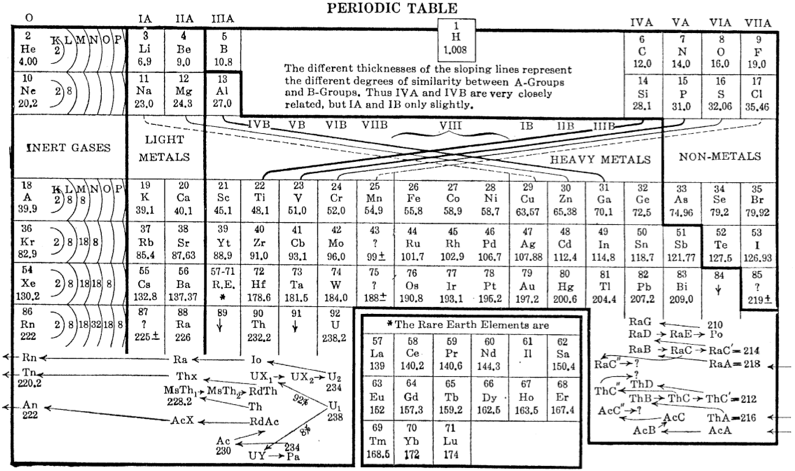
Before Moseley's discovery, the elements were ordered based on the sequence of atomic masses, and modified when a pattern could not be justified. Mendeleev had interchanged the orders of a few pairs of elements in order to put them in more appropriate places in this table of the elements. For example, the metals Cobalt and Nickel had been assigned the atomic numbers 27 and 28, respectively, based on their known chemical and physical properties, even though they have nearly the same atomic masses. In fact, the atomic mass of Cobalt is slightly larger than that of Nickel, which would have placed them in backwards order if they had been placed in the Periodic Table blindly according to atomic mass. Moseley's experiments in X-ray spectroscopy showed directly from their physics that Cobalt and Nickel have the different atomic numbers, 27 and 28, and that they are placed in the Periodic Table correctly by Moseley's objective measurements of their atomic numbers.
Moseley's Periodic Table Published in 1930
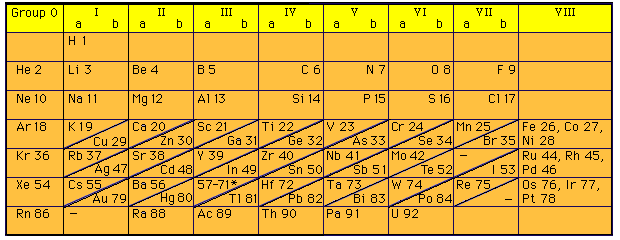
Moseley showed that there were gaps in the atomic number sequence at numbers 43, 61, 72, and 75. These spaces are now known, respectively, to be the places of the radioactive synthetic elements Technetium and Promethium, and also the last two quite rare naturally-occurring stable elements Hafnium (discovered 1923) and Rhenium (discovered 1925). Nothing about these four elements was known of in Moseley's lifetime, not even their very existence, thus he provided strong evidence that there were no other gaps in the Periodic Table between the elements with atomic number 13 and atomic number 79.
Glenn T. Seaborg, born in 1912 in Michigan, he came to Los Angeles at the age of ten. After completing undergraduate studies in Chemistry at UCLA. The last major changes to the periodic table resulted from Glenn Seaborg's work. He reconfigured the periodic table by placing the actinide series below the lanthanide series.
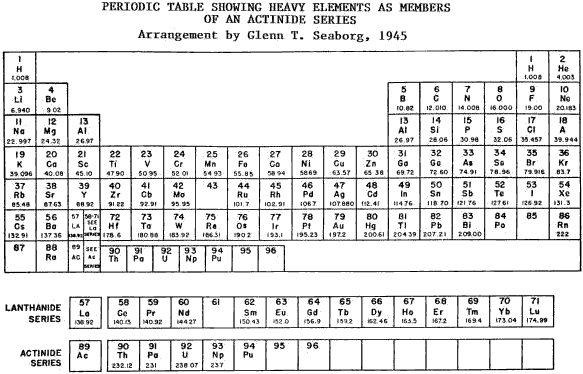
Compare and Contrast
Antoine-Laurent Lavoisier produced the first modern list of chemical elements in 1789. Previously the metals except Mercury were not considered elements. Why does the list Lavoisier produced not represent the first periodic table of elements?
Antoine Lavoisier's classification of 33 elements into four element groups Acid-making Elements Gas-like Elements Metallic Elements Earthy Elements Sulphur Light Antimony Lime (calcium oxide) Phosphorus Caloric (heat) Arsenic Magnesia (magnesium oxide) Charcoal (carbon) Oxygen Bismuth Barytes (barium sulphate) Azote (Nitrogen) Cobalt Argilla (aluminium oxide) Hydrogen Copper Silex (silicon dioxide) Muriatic Radical Gold Fluoric Radical Iron Biracic Radical Lead Manganese Mercury Molybdena Nickel Platina Silver Tin Tungstein Zinc
The list that Lavoisier produced does not place the elements in a pattern that promotes chemical prediction. Lavoiser was not able to use his table to predict a missing element or predict element behavior. Elements are placed in groups based on similar chemical properties, thus Lavoisier's list does not support the starting point for the first periodic table.
Each element in the periodic table is placed in it's location based on atomic structure. All of the elements in a period have the same number of atomic orbital's. For example, every element in the top row (the first period) has one orbital for its electrons. All of the elements in the second row (the second period) have two orbital's for their electrons. As you move down the table, every row adds an orbital. At this time, there is a maximum of seven electron orbital's.
Julius Lothar Meyer's first periodic table compared to that of John Newlands'.
In the first edition of Die modernen Theorien der Chemie (1864), Meyer used atomic weights to arrange 28 elements into 6 families that bore similar chemical and physical characteristics, leaving a blank for an as-yet-undiscovered element. His one conceptual advance over his immediate predecessors was seeing valence, the number that represents the combining power of an atom of a particular element, as the link among members of each family of elements and as the pattern for the order in which the families were themselves organized. In his original scheme the valences of the succeeding families, beginning with the carbon group, were 4, 3, 2, 1, 1, and 2.
It was not until 1870, however, that Meyer published his own table, a graph relating atomic volume and atomic number and clearly showing the periodic relationships of the elements. He did not claim priority for his achievement, and he admitted that he had been reluctant to predict the existence of undiscovered elements as Mendeleev had done. Meyer was just four years older than Mendeleev, and produced several Periodic Tables between 1864-1870.
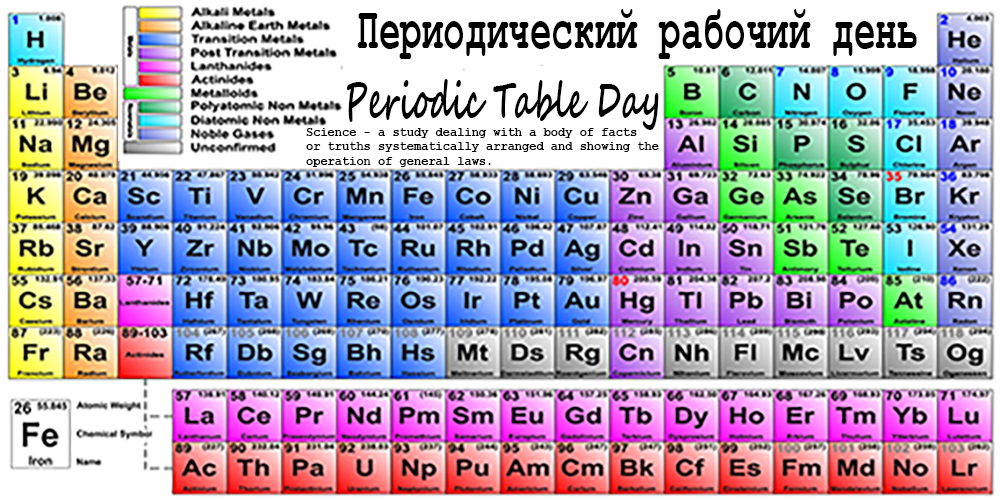



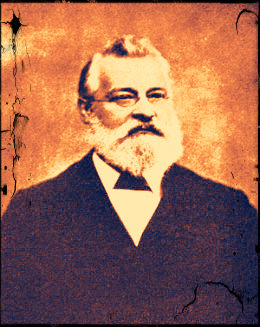
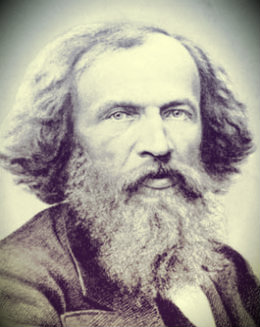
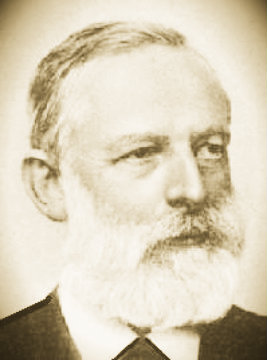
.jpg)
